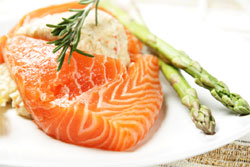- Introduction to nutrition and pain
- How is pain related to nutrition?
- What components of food are linked to pain?
- How to maintain a healthy lifestyle and minimise pain
Introduction to nutrition and pain
“Your medicine shall be your food and your food shall be your medicine.”
– Hippocrates

Ongoing pain is associated with major stress on both the mind and the body. Recent studies have shown that pain is related to a disturbance of functions within our cells. Areas of importance include omega 3 essential fatty acids and antioxidants. Glucosamine and/or chondroitin in the management of osteoarthritis is another area of interest. Excessive body weight can also worsen some types of persistent pain.
Good nutrition is important to help us feel our best and maintain our health. However, our lifestyles may be quite hectic and fast paced, leaving us little time to concentrate on eating well. By spending a bit of time to prepare proper food and eat healthily, we can help minimise any pain directly, or indirectly through methods such as weight loss.
How is pain related to nutrition?
Medical conditions
Pain is associated with some medical conditions and diseases, which can interfere with nutrition by:
- Physical changes;
- Changes in mood;
- Decrease in appetite; and
- Metabolic changes in the other processes.
This can result in an inadequate intake of healthy foods and produce malnutrition. In these circumstances, it is very important to provide good pain relief and deal with the changes produced by feeling unwell and being in pain.
Obesity
This occurs when there is an imbalance in nutrition and the total amount of calories that are consumed exceed the total that we use up through metabolic processes (such as exercising, sweating and breathing). Excess weight puts increased strain on our joints and spine. This can aggravate many painful conditions, such as arthritis and lower back pain.
Loss of excessive weight has been proven to reduce pain and improve joint function in knee osteoarthritis.
What components of food are linked to pain?
Omega 3 essential fatty acids

- Saturated fatty acids: This type of fat is found in foods such as butter and beef fat.
- Monounsaturated fatty acids: This is found mainly in chicken fat and vegetable oils such as olive, canola and peanut oil.
- Polyunsaturated fatty acids: This group includes omega 3 and 6 essential fatty acids (EFAs).There are high levels found in fish oil, vegetable and nut oils. An omega 6 EFA is linoleic acid, found mainly in corn, soy, canola, safflower and sunflower oils. An omega 3 EFA is alpha linolenic acid, present in high levels in walnut oil and fish oils. Alpha linolenic acid can be converted into eicosapentaenoic acid (EPA) and docosahexaenoeic acid (DHA).
Omega 3 fatty acids are called essential fatty acids, which means that they are essential to human health but cannot be manufactured by the body. Therefore, omega 3 fatty acids must be obtained from our diets.
To explain the relationship between pain and these fatty acids, both omega 3 and omega 6 EFAs are taken up into the membrane that surrounds each individual cell. The structure of this cell membrane then influences the metabolic function of the cell itself. It is important to maintain an appropriate balance of omega 3 and omega 6 in the diet as these two substances work together to maintain pain pathways and promote health. Omega 6 EFAs drive the cell towards more inflammatory and pain promoting pathways. Omega 3 EFAs reduce inflammation and help prevent diseases affecting our hearts and joints, like arthritis.
A healthy diet should consist of approximately one to four times more omega 6 fatty acids than omega 3 fatty acids. Studies have demonstrated clinical benefit from omega 3 EFA supplementation in conditions such as osteoarthritis, rheumatoid arthritis, fibromyalgia and neuropathic pain. There is also ongoing research about the benefits of supplementation in other inflammatory diseases such as Crohn’s disease, asthma and psoriasis. Our risk of coronary artery disease is decreased, due to improved lipid profiles and diminished clotting tendency.
Antioxidants
Antioxidants are substances that help the body get rid of potentially harmful molecules called free radicals. The use of oxygen in the body’s normal processes creates these free radicals. These radicals consist of an unstable outer layer of electrons, which can take electrons from other neighbouring cells and damage them. Some situations increase the production of these radicals, such as smoking, stress, radiation injury and excessive dietary fat intake. The role of antioxidants is to “mop up” free radicals. They donate electrons to unstable free radicals, which changes them into a stable form. It is important to maintain a balance between oxidative and anti-oxidative systems. If this balance is disrupted, excess free radicals can result in cancer and are implicated in the ageing process.
Pain is thought to be an oxidative stress. The presence of free radicals may play a role in development and maintenance of ongoing pain. Thus antioxidants are important to counteract these radicals. Studies have shown benefits of antioxidant therapy in acute pain, fibromyalgia (pain in the fibrous tissues in the body such as muscles, tendons, and ligaments), dysmenorrhoea (period pain), painful diabetic neuropathy, osteoarthritis and recurrent pancreatitis.
Examples of some antioxidants include vitamin C, E, selenium and beta-carotene. Fresh fruit and vegetables are good sources of antioxidants. Other sources include green tea and red wine.
Glucosamine and chondroitin
Glucosamine is a substance found naturally in the body. It can be produced from glucose (sugar) and an amino acid called glutamine. It can also be found in dietary sources such as shellfish. Glucosamine is believed to play a role in cartilage formation and repair. It is a building block for mucopolysaccharides, which are found in cartilage, bone, ligaments, hair, nails and skin.
Chondroitin is part of a large protein molecule (proteoglycan) that gives cartilage its elasticity.
Many studies suggest benefit in osteoarthritis from the use of glucosamine supplements. A recent 5 year trial called the “GAIT” (Glucosamine/Chondroitin Arthritis Intervention Trial) study shows that a combination glucosamine and chondroitin sulfate is effective in treating moderate to severe knee pain due to osteoarthritis.
How to maintain a healthy lifestyle and minimise pain
Australian Dietary Guidelines recommend at least five servings of vegetables and two of fruit a day. This should provide adequate antioxidant levels. However, if the nutritional value of the fruit and vegetables is sub-optimal there may be benefits in dietary antioxidant supplementation (including vitamins C and E, beta-carotene and/or selenium).
- The National Physical Activity Guidelines for Australians recommends at least 30 mins of moderate-intensity physical activity on most, preferably all, days of the week. Regular exercise is important to maintain an optimal body weight and reduce stress on our weight bearing joints, like our knees. Best results are achieved from combining regular physical activity with a healthy, well balanced diet.
- To maintain the desired ratio of omega 6 to omega 3 fatty acids we can ensure high omega 3 levels by eating free-range eggs, “grass fed” beef and fish oils.
- Glucosamine supplements can be taken in the diet, to help pain associated with osteoarthritis. The recommended dose of glucosamine sulphate is 500 mg 3 times a day.
More information
 |
For more information on nutrition, including information on types and composition of food, nutrition and people, conditions related to nutrition, and diets and recipes, as well as some useful videos and tools, see Nutrition. |
References
- Bagis S, Tamer L, Sahin et al. Free radicals and antioxidants in primary fibromyalgia: an oxidative stress disorder? Rheumatol Int; 2003
- Curtis CL, Rees SG, Cramp J et al. Effects of n-3 fatty acids on cartilage metabolism. Proceedings of the Nutrition Society 61(3):381-389, 2002
- Curtis CL, Rees SG, Little CB et al. Pathologic indicators of degradation and inflammation in human osteoarthritic cartilage are abrogated by exposure to n-3 fatty acids. Arthritis & Rheumatism 46(6):1544-1553, 2002
- James MJ, Cleland LG. Dietary n-3 fatty acids and therapy for rheumatoid arthritis. Seminars in Arthritis & Rheumatism 27(2):85-97,1997
- Kjeldsen-Kragh J, Lund JA, Riise T et al. Dietary omega 3 fatty acid supplementation and naproxen treatment in patients with rheumatoid arthritis. Journal of Rheumatology 19(10):1531-1536, 1992
- National Institute of Health, Questions and Answers: NIH Glucosamine/Chondroitin Arthritis Intervention Trial (GAIT), [online]. 2006 [cited 12th April 2006]. Available from URL: http://nccam.nih.gov/research/results/gait/qa.htm
- Nielsen GL, Faarvang KL, Thomsen BS et al. The effects of dietary supplementation with n-3 polyunsaturated fatty acids in patients with rheumatoid arthritis: a randomised, double blind trial. European Journal of Clinical Investigation 22(10):687-691, 1992
- NSW Health, Nutrition & Pain, Community Information Series, Hunter Integrated Pain Service; 2005
- Ozgocmen S, Catal SA, Ardicoglu O, Kamanli A. Effect of omega-3 fatty acids in the management of fibromyalgia syndrome. International Journal of Clinical Pharmacology and Therapeutics 38(7):362-363, 2000
- Pain & Nutrition [online]. 2005 [cited 12th April 2006]. Available from URL: http://www.doctorsforpain.com/patient/nutrition.html
All content and media on the HealthEngine Blog is created and published online for informational purposes only. It is not intended to be a substitute for professional medical advice and should not be relied on as health or personal advice. Always seek the guidance of your doctor or other qualified health professional with any questions you may have regarding your health or a medical condition. Never disregard the advice of a medical professional, or delay in seeking it because of something you have read on this Website. If you think you may have a medical emergency, call your doctor, go to the nearest hospital emergency department, or call the emergency services immediately.

 Australian Dietary Guidelines recommend at least five servings of vegetables and two of fruit a day. This should provide adequate antioxidant levels. However, if the nutritional value of the fruit and vegetables is sub-optimal there may be benefits in dietary antioxidant supplementation (including vitamins C and E, beta-carotene and/or selenium).
Australian Dietary Guidelines recommend at least five servings of vegetables and two of fruit a day. This should provide adequate antioxidant levels. However, if the nutritional value of the fruit and vegetables is sub-optimal there may be benefits in dietary antioxidant supplementation (including vitamins C and E, beta-carotene and/or selenium).





